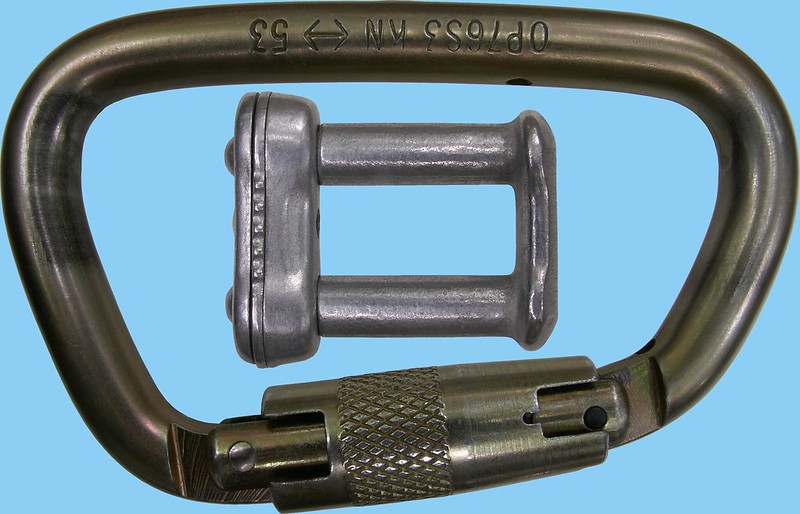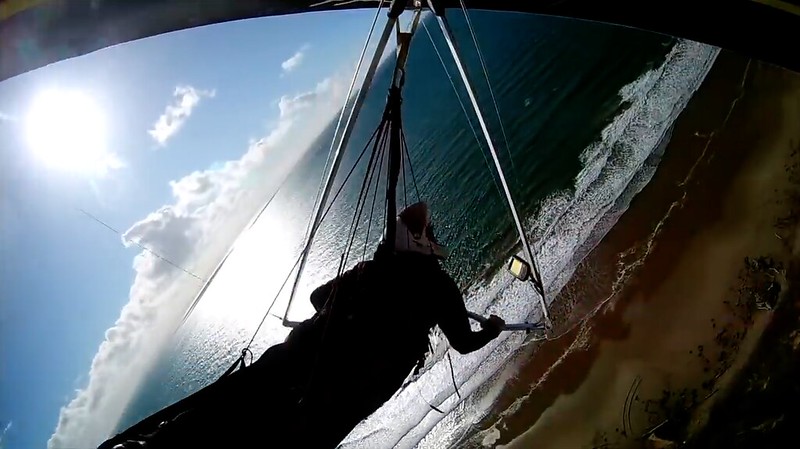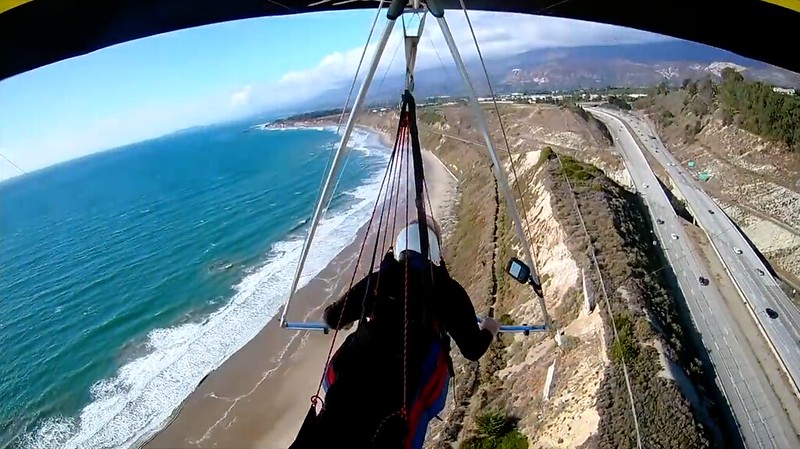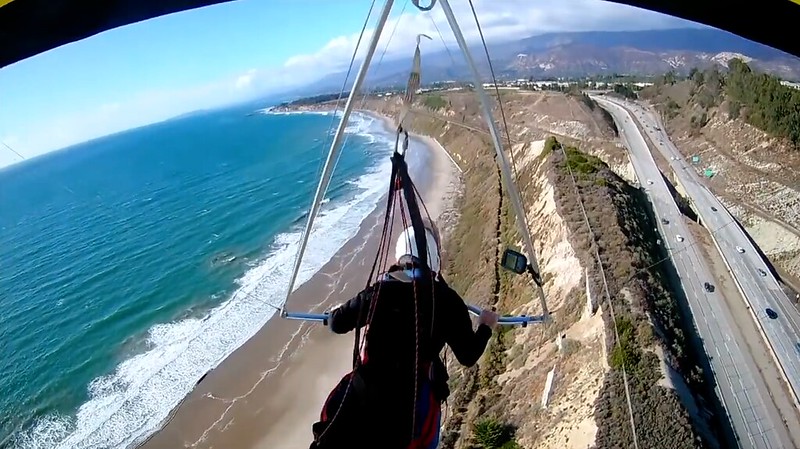http://www.hanggliding.org/viewtopic.php?t=36979
Spectra (Dyneema) for Hang Straps
CloudDiver - 2021/02/03 20:49:21 UTC
Before I give my .02 cents I will qualify my experience in this area. I'm a professional rigger for sailboats and I specialize in Dyneema Rigging, I've been doing this for close to 7 years now. I replace standing rigging (the wires that support the mast) with heat annealed Dyneema. On the smallest boats like my Nacra 5.2 Cat, its only 4mm. The largest boat I've done is a 56 ft John Alden Ketch that had 22 shrouds & stays. I used 11mm core on the main mast, 7 mm on the mizzen mast. In any case, I use Dyneema sized to account for creep so its usually 1 size larger in mm than the original wire was, but the manufacturer rated tensile strength is about 2x stronger than that 1x19 wire was. I always use a Dyneema cover on the shrouds I make because the life expectancy of uncovered Dyneema is 5 to 8 years of UV exposure. After that time the core loses about 50% of its original rated tensile strength.
Ok, that said and based on some of the statements above;
- The average strength of 1 inch Nylon Flat webbing is 4200 lbs
- 6 or 7mm Dyneema would be way overkill and massive windage.
-There are many 'flavors' of Dyneema (SK 75, 78, 90, 99) and all of these can come plain or heat annealed. So determining which size to use that meets or exceeds 42000 lbs in tensile depends on what brand and type you want to use.
- Knots: Dyneema should always be spliced, knots should be avoided in any load bearing application. Dyneema is very slippery compared to other ropes, large sizes do not hold knots well. Its super easy to splice Dyneema into an infinite loop.
- UV cover; Sure you can, but its not a big deal in this application. Wings spend the majority of their lives packed into their bags, not in direct sunlight 12 hours a day. The 5 to 8 years metric I mentioned above is for constant UV exposure on the deck of sailboat, 12 hours a day. The size of Dyneema that would be good for hang-loops (I'd use 5 mm if it were not heat annealed) is so cheap that I would realistically just replace the hang loop every 5 years and that would be a very, very generous safety margin.
I would generally say that while Dyneema has more than adequate strength for hang-loop application and I would have absolutely no reservations about flying with one that I made for myself I still wouldn't recommend it over sewn Nylon flat webbing and here is why;
Windage: Even if I use the smallest size SK99 heat annealed core that meets or exceeds 4200 lbs, probably 3 mm, it will still have more drag compared to flat webbing pointed into the wind. Given the amount of surface area we are talking about its probably insignificant to noticeable performance, but drag is drag.
Shock Loading: Dyneema has very, very, very low stretch compared to nylon webbing. For the application of hang-loops, stretch is a good thing. This is the same reason why Rock-Climbers use dynamic (stretchy) ropes instead of static ropes for fall protection... ask any climber that has taken a big whipper. For nylon webbing the back-up hang-loop should only be 1/8 to 1/4 inch longer than the back up. The idea is that you shouldn't be anticipating that the primary actually breaks before the back up is engaged, the primary can stretch without breaking to the point where the back-up is engaged. Since Dyneema has so much less stretch this dynamic would totally change. Further, and this greatly depend on how the hang loops are attached to the frame, a smaller diameter Dyneema loop will focus its load on a smaller area where 1 wide flat webbing distributes it over a larger area. Obviously I'm talking about single surface wings with the simple Lark's head around the keel. I doubt seriously that any amount of pilot weight amplified through bouncing in turbulence or any other flight condition would put enough force on the loop to break the keel, but IF it could happen it would be more likely to happen from a small diameter Dyneema loop that is static than it would be likely to happen from flat webbing that is dynamic. If anyone brings up reserve chute deployment, just stop right there... that's not how it works.
So in summary.... Dyneema isn't BAD per se, definitely more than capable in terms of tensile strength. Simply put, flat nylon webbing works great and has better windage in profile, so there is no need to try Dyneema loops. I wouldn't want to do it on a Falcon for reasons I stated above, plus the the CG will be easier to slip out of position. My old Sport 2 is in storage so I can't look at it and my new Sport 3 is being built. When I get the new Sport 3 maybe I'll take a closer look and make a sample/feasibility test.
- Luke - H2, USHPA #101609
Before I give my .02 cents...
.02 cents is 0.0002 dollars - one fiftieth of a penny. But yeah. That IS closer to what this post is worth.
I will qualify my experience in this area.
I don't give a flying fuck about your EXPERIENCE in this area. This issue has ZILCH to do with experience - it's all about theory and engineering. And you've flunked before you've started.
I'm a professional rigger for sailboats...
Yeah sailboats. Float around with their hulls in one fluid medium and their sails and rigging flying in another. And the only place they're not bending over backwards to eliminate or minimize flex and elasticity is their anchor line - the thing that stops them from doing what they're designed and built to do.
Ok, that said and based on some of the statements above;
- The average strength of 1 inch Nylon Flat webbing is 4200 lbs
The minimum strength of an HGMA or equivalent certified glider is about six Gs. And for a 250 pound hook-in guy we're talking about 16.8 Gs. And that's before we start thinking about the issue of it being DOUBLED to form a LOOP - which, by the way, you NEVER do in this post.
- 6 or 7mm Dyneema would be way overkill and massive windage.
And the factory gear of course isn't. But let's...
Mike Meier - 2005/08/~18
It shouldn't matter whether the backup is in front or behind, because it should be longer than the main such that it is always slack in flight. An argument could be made that IF the main hang loop broke, you'd rather have the backup in front because the most likely scenario in which you'd break the main would be pulling high positive G's, and in that case you'd rather have the pitch trim become more nose down than become more nose up, but on a Falcon 2 that's not really a consideration. As far as where the backup "usually" goes, we usually put it behind the main because that's usually where there's room for it. If the main is properly maintained, and periodically replaced, it is never going to fail anyway, so the backup is sort of pointless. Years ago we didn't even put backup hang loops on our gliders (there's no other component on your glider that is backed up, and there are plenty of other components that are more likely to fail, and where the failure would be just as serious), but for some reason the whole backup hang loop thing is a big psychological need for most pilots.
...back it up anyway just to be on the safe side.
-There are many 'flavors' of Dyneema (SK 75, 78, 90, 99) and all of these can come plain or heat annealed. So determining which size to use that meets or exceeds 42000 lbs in tensile depends on what brand and type you want to use.
Yeah, let's use that 21 ton figure as our yardstick. Really hard to go wrong that way. It's not like the hang gliding industry guys just grabbed some off-the-shelf climbing gear and pronounced it standard. Nah, we arrived at all this stuff after years of careful engineering studies, flight testing, incident analysis, and an incredible degree of trail and error on top of all that.
- UV cover; Sure you can, but its not a big deal in this application. Wings spend the majority of their lives packed into their bags, not in direct sunlight 12 hours a day. The 5 to 8 years metric I mentioned above is for constant UV exposure on the deck of sailboat, 12 hours a day. The size of Dyneema that would be good for hang-loops (I'd use 5 mm if it were not heat annealed) is so cheap that I would realistically just replace the hang loop every 5 years and that would be a very, very generous safety margin.
Probably also be a good idea to change your hang glider's sail every two and a half years 'cause those things are getting a lot more UV exposure per square inch and the material's a fraction of the thickness of the strap.
Shock Loading:...
Yeah, Shock Loading...
http://ozreport.com/forum/viewtopic.php?t=24846
Is this a joke ?
Jim Rooney - 2011/08/28 19:39:17 UTC
Weak links break for all kinds of reasons.
Some obvious, some not.
One of the biggest bits that seems to be under appreciated is the bit that weaklinks break under shock loading.
They can take a hell of a lot more force if they're loaded slowly... which is exactly what happens in a lockout.
One of the biggest bits that seems to be underappreciated is that materials fail at much lower loads when they're surprised by the suddenness of the application and are deprived of the opportunity to start bracing themselves adequately.
Dyneema has very, very, very low stretch compared to nylon webbing.
Which makes it much more vulnerable to the shock loads we often encounter when flying through turbulence. So let's back it up just to be on the safe side.
For the application of hang-loops, stretch is a good thing.
Obviously. What other reason would we have for using nothing but nylon for our glider and harness suspension from the beginning of time up to the present? Just imagine the number of gliders we'd have torn to shreds flying through turbulence otherwise.
This is the same reason why Rock-Climbers use dynamic (stretchy) ropes instead of static ropes for fall protection... ask any climber that has taken a big whipper.
Rock climbers - you moron - are anchoring themselves to 1500 foot tall slabs of granite that haven't moved more than an inch and a half over the course of the past fifty thousand years. And they're falling fifty feet. Not quite the same thing as what's going on with hang glider suspension. The most we can fall is maybe three and a half feet between getting slammed against the keel and full suspension. And if we're in a situation like that the strength and elasticity of our hang loop are at the absolute bottom of our list of concerns.
For nylon webbing the back-up hang-loop should only be 1/8 to 1/4 inch longer than the back up. The idea is that...
...it's a big psychological need for most pilots.
...you shouldn't be anticipating that the primary actually breaks before the back up is engaged, the primary can stretch without breaking to the point where the back-up is engaged.
- Wow! Pure genius! Your talents are being totally wasted as a sailboat rigger. I'da thunk that you'd have been snatched up by a top glider manufacturer years ago.
- What are you imagine is going on with the glider and pilot and as things are transitioning through thirty Gs? Adam Parer would've been a good individual to consult on issues like these but we can't anymore.
Since Dyneema has so much less stretch this dynamic would totally change. Further, and this greatly depend on how the hang loops are attached to the frame, a smaller diameter Dyneema loop will focus its load on a smaller area where 1 wide flat webbing distributes it over a larger area. Obviously I'm talking about single surface wings with the simple Lark's head around the keel.
- A keel heavily sleeved in the relevant area. But we should do some bench testing anyway to see what it takes to choke it to the point of deformation with webbing over a range of widths.
- You're flying gliders with kingpost suspension. And most of the gliders doing most of the flying in most of the demanding conditions and situations aren't flying with crap Lark's Headed around the keel. They're flying like you are - with kingpost or rocker hardware connections.
I doubt seriously that any amount of pilot weight amplified through bouncing in turbulence or any other flight condition would put enough force on the loop to break the keel, but IF it could happen it would be more likely to happen from a small diameter Dyneema loop that is static than it would be likely to happen from flat webbing that is dynamic.
And no glider has ever failed in the course of a tumble or blown aerobatic maneuver so we have no fuckin' clue as to which structural components start snapping first - which are the outboard leading edge sections and cross spars.
If anyone brings up reserve chute deployment, just stop right there... that's not how it works.
You should've stopped before you started.
So in summary.... Dyneema isn't BAD per se, definitely more than capable in terms of tensile strength. Simply put...
http://www.chgpa.org/forums/viewtopic.php?f=2&t=2871
speed link
JD Guillemette - 2008/02/07 12:51:57 UTC
For these same reasons, It just bothers me when people try to "improve" upon Bobby Bailey's designs ... simply put, the designs are at the maximum of efficiency and safety. So I'm right back to where I was. I see no problem in the way things are currently done and creating overly complicated mouth actuated releases is just a waste of time.
...flat nylon webbing works great...
Wow. just like the Standard Aerotow Weak Link. If it ain't broke... Don't worry. It will be at the worst possible time...
Donnell Hewett - 1980/12
Now I've heard the argument that "Weak links always break at the worst possible time, when the glider is climbing hard in a near stall situation"...
...when the glider is climbing hard in a near stall situation.
...and has better windage in profile...
What's the windage profile of a fluttering backup loop?
...so there is no need to try Dyneema loops.
Yeah, if it ain't broke... See above.
I wouldn't want to do it on a Falcon for reasons I stated above...
Has anyone on a lower performance glider ever been in a situation in which he needed every inch of performance he could get to make it to a safe field or keep himself from being blown over the back? Lower performance gliders are flown because they're cheaper, lighter, require lighter effort. So hell, let's just keep throwing more useless crap into the airflow 'cause we're never gonna be able to match a topless bladewing anyway.
...plus the the CG will be easier to slip out of position.
- So the existing configuration allows the connection to slip, but not as easily as it most assuredly would using Dyneema rather than nylon. Has there ever been any documentation of this actually happening?
- And there'd be no freakin' way we could glue a rubber strip along the top of the relevant area of the keel to eliminate any possibility of any material being able to slip when loaded.
- A one and a half ton Speed Link...

...will break at a quarter the load a six ton steel carabiner will hold. So obviously we should all be flying with the six ton carabiner 'cause that's four times as safe. Maybe use a backup for good measure.
My old Sport 2 is in storage so I can't look at it and my new Sport 3 is being built. When I get the new Sport 3 maybe I'll take a closer look and make a sample/feasibility test.
I can hardly wait. It's through the efforts of individuals such as yourself that this sport constantly evolves to hitherto unimaginable heights. And you're managing to do this without pissing off Jack and or any of his other coffee shop patrons.



